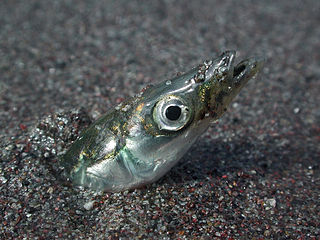
A sand lance or sandlance is a fish belonging to the family Ammodytidae. Several species of sand lances are commonly known as "sand eels", though they are not related to true eels. Another variant name is launce, and all names of the fish are references to its slender body and pointed snout. The family name means "sand burrower", which describes the sand lance's habit of burrowing into sand to avoid tidal currents.
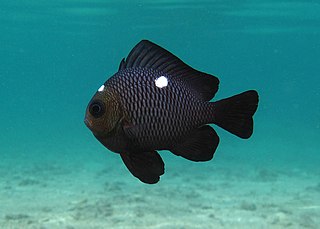
Dascyllus is a genus of fish in the family Pomacentridae. They are usually commensals with corals.

Pseudojuloides is a genus of wrasses native to the Indian and Pacific Oceans.

Gymnothorax is a genus of fish in the family Muraenidae found in Atlantic, Indian, and Pacific Oceans. With more than 120 species, it the most speciose genus of moray eels.
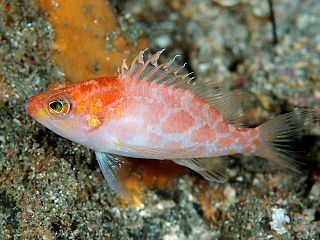
Plectranthias is a genus of ray-finned fish in the subfamily Anthiinae, part of the family Serranidae, the groupers and sea basses. They are found in the Atlantic, Indian and Pacific Ocean.

Cirrhilabrus, the fairy wrasses, is a genus of fish in the family Labridae native to coral reefs and nearby habitats in the Indo-Pacific region. They are brightly colored and do not surpass 16 cm (6.3 in) in length. Males are larger and more colorful than females. They are commonly kept in aquaria.

Pseudochromis is a genus of fish in the family Pseudochromidae found in Indian and Pacific Ocean.

Sillago is a genus of fish in the family Sillaginidae and the only non-monotypic genus in the family. Distinguishing the species can be difficult, with many similar in appearance and colour, forcing the use of swim bladder morphology as a definitive feature. All species are benthic in nature and generally coastal fish, living in shallow, protected waters although there are exceptions. Minor fisheries exist around various species of Sillago, making them of minor importance in most of their range. This genus has the widest distribution of any smelt-whiting genus, spanning much of the Indo-Pacific. The genus ranges from the east coast of Africa to Japan in the east and Southern Australia in the south, with most species concentrated around South East Asia, the Indonesian Archipelago and Australia. Many species have overlapping distribution, often making positive identification hard.

Pseudanthias is a genus of colourful reef fishes of the subfamily Anthiinae, part of the family Serranidae, the groupers and sea basses. They are found in the Indo-Pacific. The species belonging to this genus have a diet consisting of zooplankton, and are haremic. Fishes currently included in this genus were earlier part of the genus Anthias. Pseudanthias is the largest anthiine genus

Trichonotus is a genus of marine gobiiform fishes. Species of Trichonotus are distributed throughout the Indo-West Pacific. This genus is the only member of the family Trichonotidae.

Paracheilinus is a genus of flasher wrasses, native to the Indian Ocean and the western Pacific Ocean.

Raitt's sand eel, is a small semi-pelagic ray-finned fish found in the North Atlantic Ocean. The Raitt's sand eel is member of the family Ammodytidae which includes all 31 species of sand eels, often referred to as sand lances. Contrary to their name sand eels, including Raitt's sand eel, are not true eels and instead belong to the order of “weever-like” fishes, the Trachiniformes.
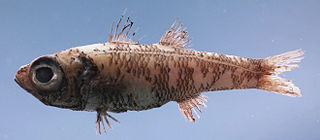
Epigonus is a genus of fish in the family Epigonidae found in the Atlantic, Indian and Pacific Ocean. The genus was erected by Constantine Samuel Rafinesque in 1810.
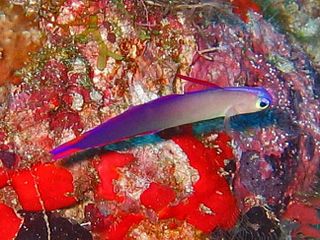
Nemateleotris is a genus of dartfishes native to the Indian and Pacific oceans.

Parapercis is a genus of sandperches belonging to the family Pinguipedidae.

Acropoma is a genus of fish in the family Acropomatidae, the temperate ocean-basses or lanternbellies. They are native to the Indian Ocean and western Pacific Ocean. They are characterized by a ventral luminous organ that has a luminous gland, a lens, and a reflector. The shape of the luminous organ helps distinguish the species in the genus.
Ammodytoides is a genus of sand lances native to the Indian and Pacific oceans.
Protammodytes is a genus of sand lances found in the Atlantic and Pacific oceans.
Pseudamiops is a genus of cardinalfishes native to the Pacific and Indian oceans.

Pempheris is a genus of sweepers native to the Atlantic, Indian and Pacific Ocean.

















